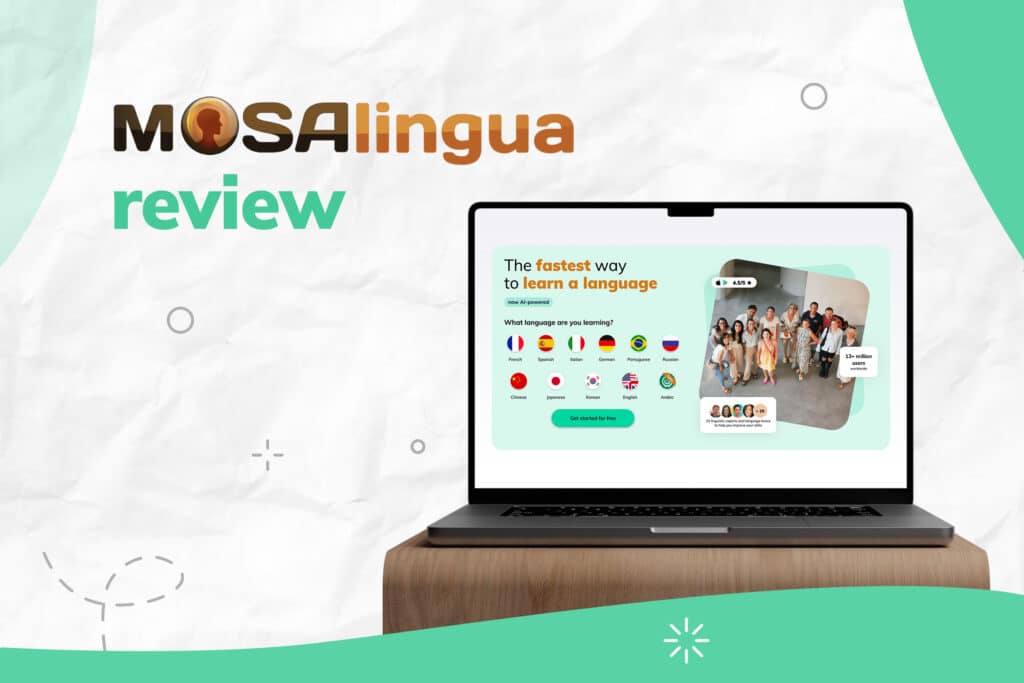
My Honest MosaLingua Review: Great for Vocab Building but Lackluster User Experience
MosaLingua first started as a vocabulary flashcard app and is now a holistic program that teaches the 6,000 most used words in a language with the help of spaced repetition.
In fact, all of MosaLingua’s approach, which they call MosaLearning, consists of scientifically researched methods that optimize language learning and memorization.
I used MosaLingua Premium to study Spanish for two weeks. Although the vocabulary teaching method and authentic content are great, it’s a bit lacking in user-friendliness and it can feel a little repetitive.
Overview
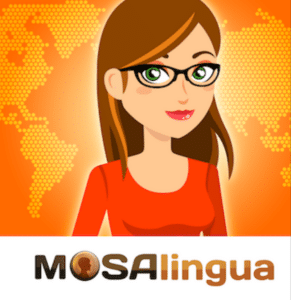
Name: MosaLingua
Description: MosaLingua is a spaced repetition vocabulary and holistic language learning program that includes flashcards, video, dialogues and authentic materials to teach.
Languages offered: English, French, Spanish, Portuguese, German, Italian, Russian, Chinese, Japanese and Korean
Offer price: Starting at $4.99 per month
Summary
MosaLingua is great at what it started out being: a spaced repetition vocabulary flashcard app. It also includes authentic content and many ways to learn, but the user experience is a little lackluster and it can tend to get repetitive after a while because it doesn’t have a gamefied element.
- User Friendliness - 6/106/10
- Delivers on Promises - 7/107/10
- Authenticity - 6/106/10
- Value - 7/107/10
Pros
- Gets you learning useful words and phrases right away
- Spaced repetition method is backed up by research
- MosaChat-AI works really well
- Immersion style teaching with very little English
Cons
- Not as user friendly as it should be
- Not as effective for Chinese and Japanese
- Design and user interface could be better
- Immersion style can be difficult for beginners
Contents
- Key Features of MosaLingua
- What’s Great About MosaLingua?
- What’s Not So Great About MosaLingua?
- MosaLingua Versus Other Language Learning Programs
- What Does MosaLingua Cost?
- The Final Verdict: Does MosaLingua Live Up to Its Promises?
- And One More Thing...
Download: This blog post is available as a convenient and portable PDF that you can take anywhere. Click here to get a copy. (Download)
Key Features of MosaLingua
Spaced repetition vocabulary flashcards
Flashcards are at the heart of MosaLingua. In fact, the program started out focusing on flashcards. After you choose a level (from beginner to level nine, which is specialized terms) for your flashcards, you begin going through commonly used words and phrases.
You can choose your reason for learning, ranging from travel to work or passing a language exam. Each of these categories will bring up a unique set of words, although there is some overlap of course. It’s also worth noting that even in the advanced vocab levels, you still get beginner words because of the spaced repetition. I personally loved this gentle nudge to remember older words as I was venturing forward.
In Spanish, the beginner flashcards started teaching me how to say hello, please, thank you, commonly used phrases like hasta luego (see you later) and essential phrases like ¿Podría ayudarme? (Can you help me?) and no sé (I don’t know).
After you hear the word or phrase being spoken by a native speaker, you flip the card to reveal the word and meaning. If you want, you can save the card to a “learning stack” or you can dismiss the card if you feel that you have memorized it, or if you already knew it.
You also have the opportunity to study the card in a few different ways. You can write it using fill-in-the-blanks letters, hear it spoken, see a photo illustration of the word or phrase and lastly, you can record yourself saying it. This was my favorite feature because sometimes you think you’re pronouncing a word correctly, but then you hear the reality of your audio recording, which you can compare to a native speaker the word of phrase.
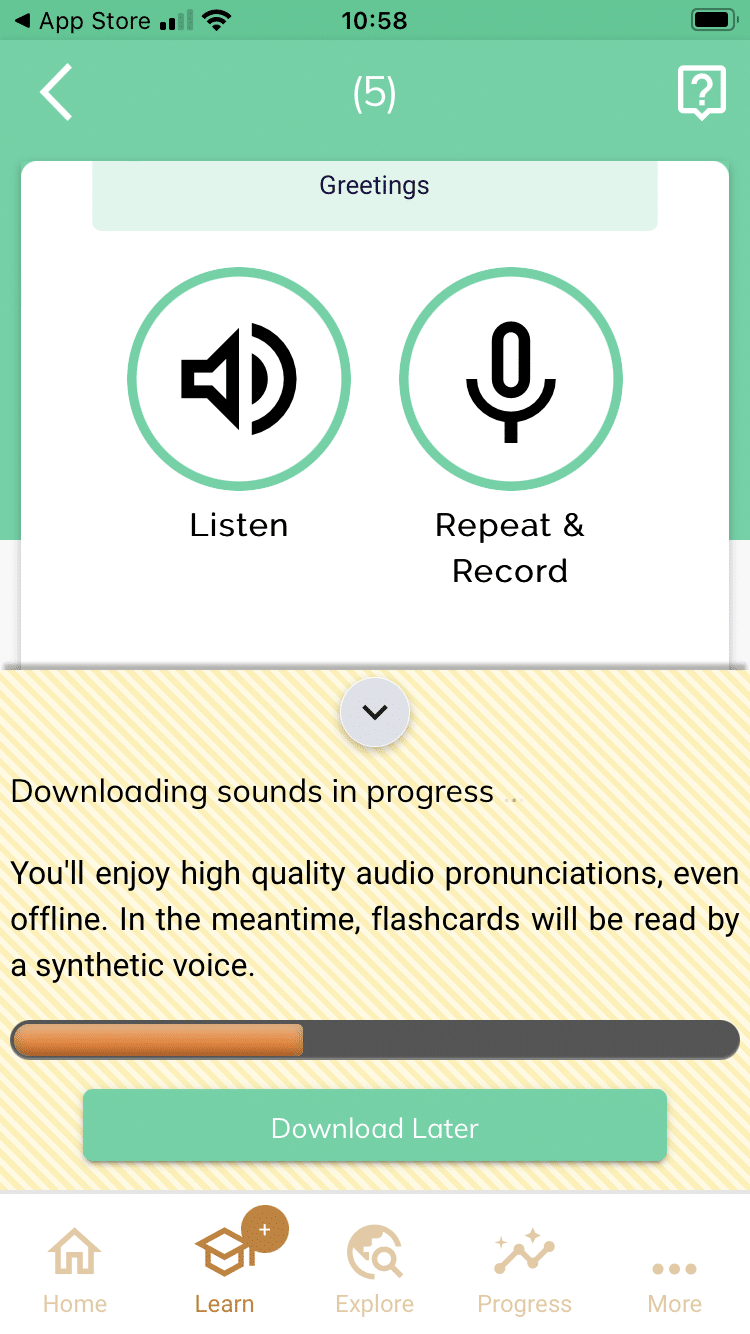
You can also see a photo representation of the word and you can spell them out.
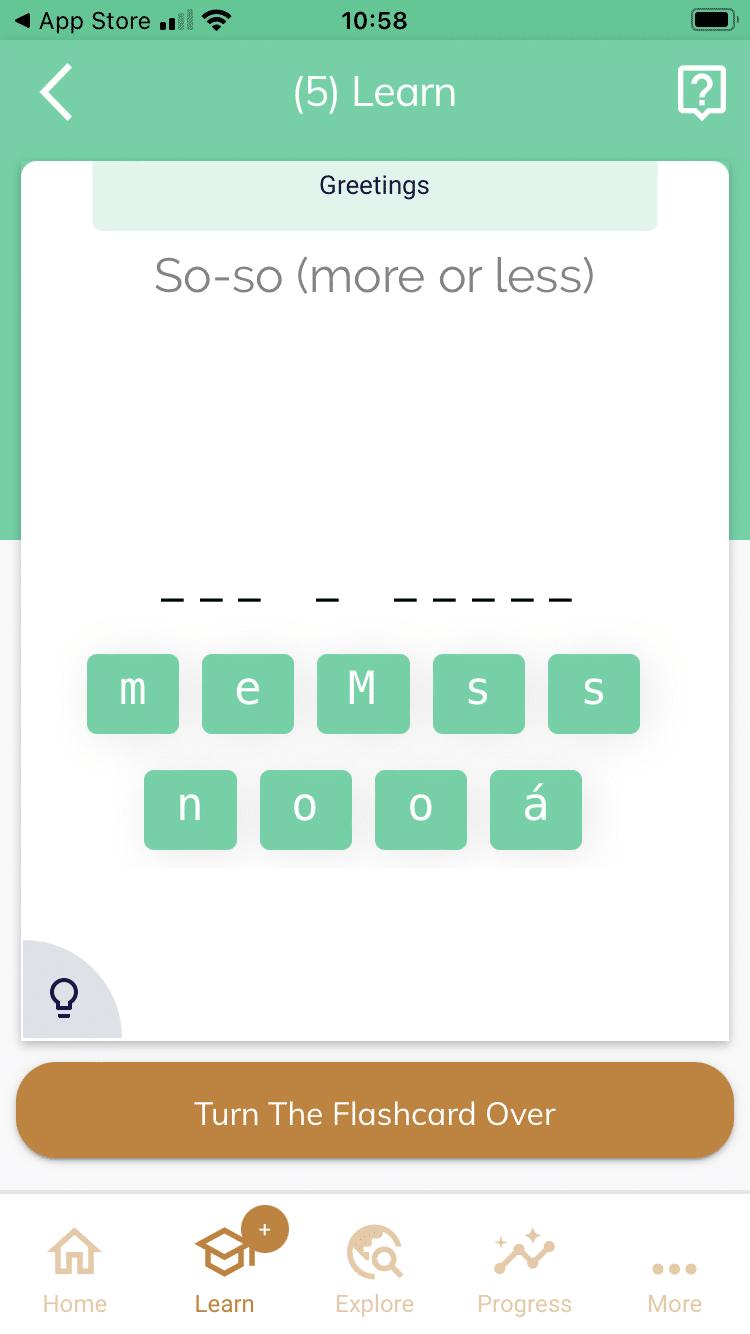
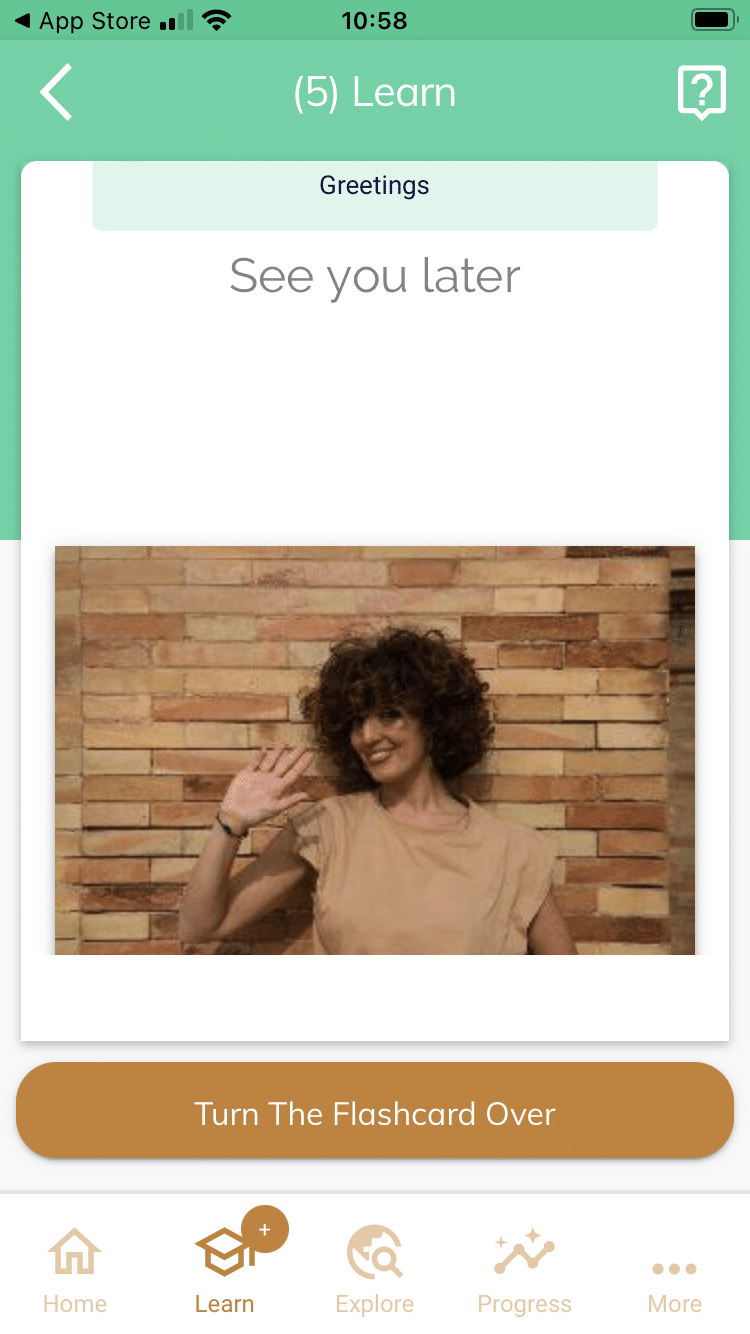
The flashcards have worked really well for me. I’ve learned (and re-learned) at least 10-20 new words per day using these, so I can confidently say they’re effective. And I enjoy reviewing my progress by reviewing the words in my learning stacks.

Spoken dialogues
Spoken dialogues are a way to develop your listening skills as you hear a dialogue in your target languages about a wide variety of topics, from cooking to travel. I liked a few of these, but honestly, I stopped listening to them after a couple of days because of their lack of interactivity. They’re basically like slide shows with people talking over them, which I guess is a good way to learn in a more passive way.
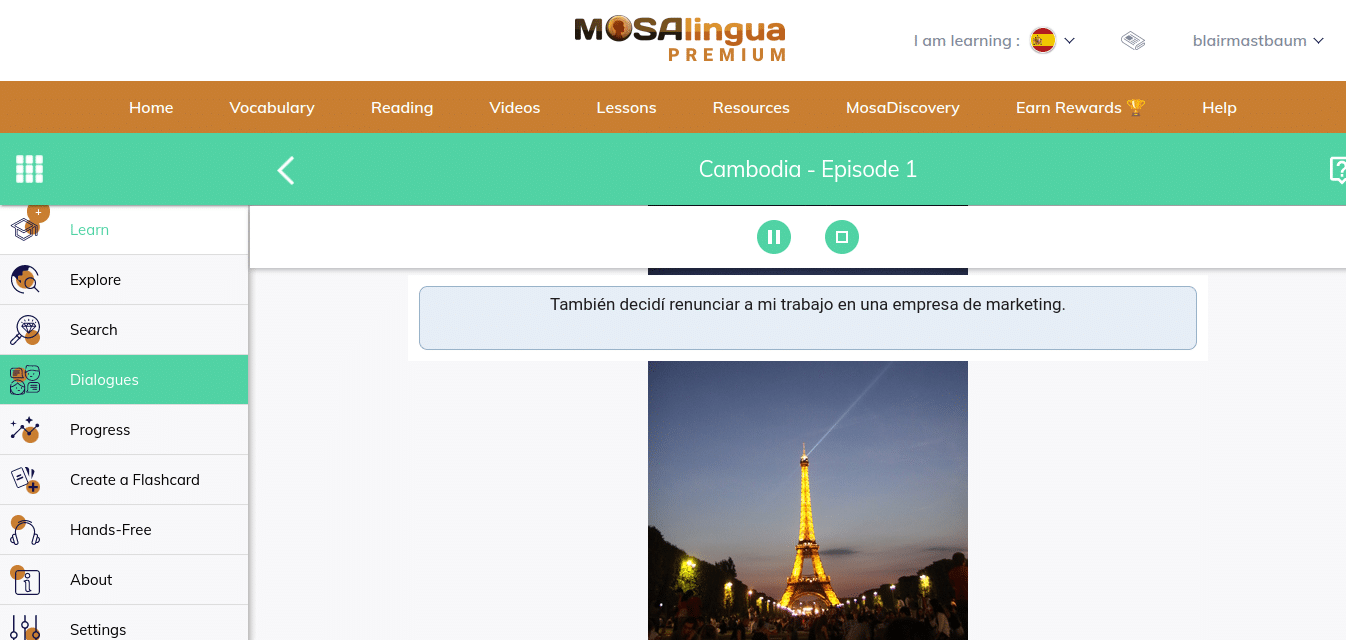
Hands-free mode
When you go into hands-free mode, the app plays a loop of words in the mother tongue and the target language, so you can keep learning and hearing vocabulary words and phrases on-the-go.
Reading activities
MosaLingua has a lot of graded (meaning put into learning levels from beginner level to intermediate) reading materials that focus on all kinds of subjects from restaurants to travel to what people do on the weekend.
You can either just read or you can hear them being read to you as you follow along. I liked this section quite a bit because I’m the type of learner who likes to see the words as I hear them. I find I memorize them more easily this way. If you’re like me, you’ll appreciate these reading resources, too.
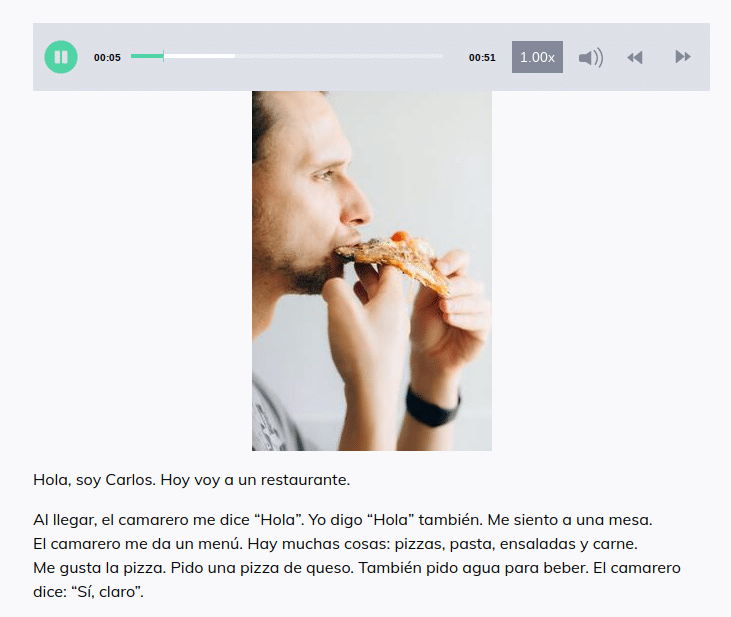
There’s also a selection of novels for each language, though the novels in the Spanish section were a little too advanced for my Spanish level (“Don Quixote” anyone?).
Grammar, pronunciation and conjugation lessons
These grammar and pronunciation lessons are well done and easy to understand. Some have videos included and most have audio.
But they do lack a way to practice the skill after you do the lesson, so, for me, I tended to forget a lot of it. I think that supplementing these lessons with things like worksheets and PDFs would really help commit them to memory.
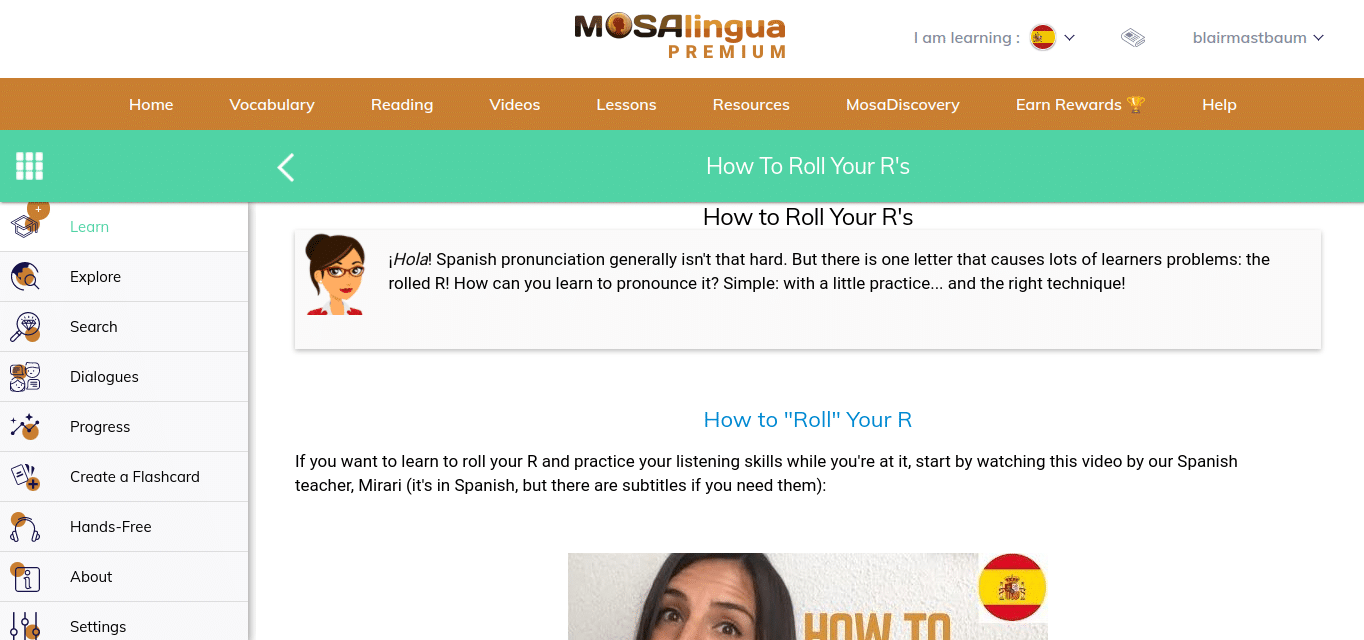
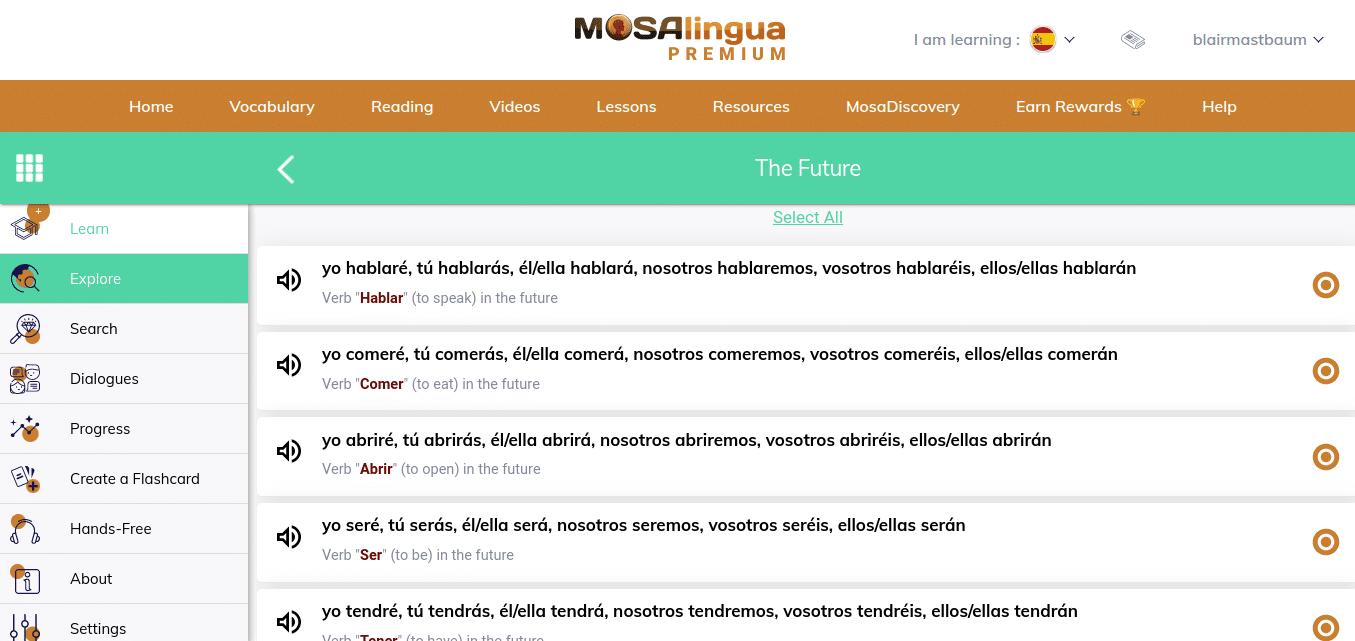
Video content
There is a large authentic video component to MosaLingua. The videos are all authentic, meaning that they’re made for and by native speakers. They all come with scrolling subtitles, either in English or in the language of the video, or both.
I did watch some videos during my two weeks doing MosaLingua, but to be honest, I enjoy FluentU‘s videos much more because they have interactive subtitles and even personalized quizzes after each video.
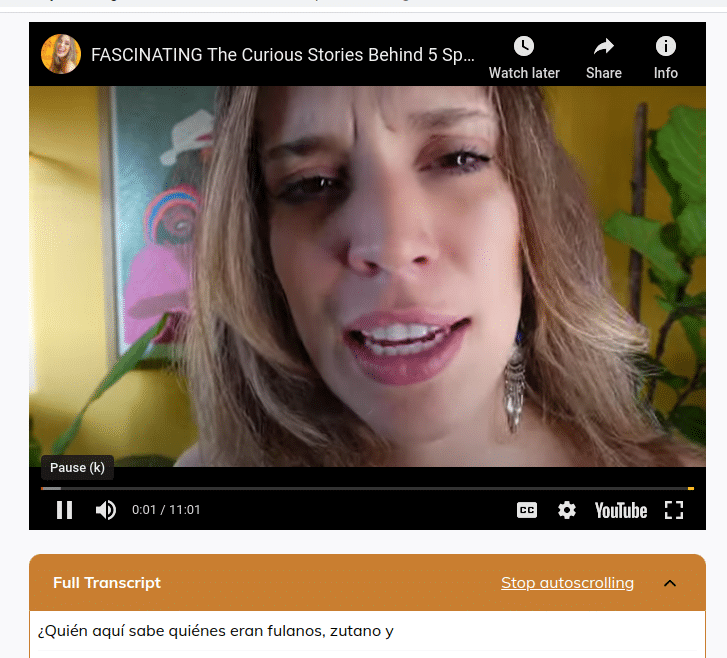
MosaChat-AI
Although this AI chat function with an AI tutor called Alda is in beta, I found that it worked really well.
One caveat is that the AI tutor can be quite slow in responding. I didn’t mind this so much because it gives you a bit of time to rest your mind.
When prompted by Alda, I asked to talk about travel. She asked some simple questions and I responded, doing the best I could to type in Spanish.

She received my responses warmly and enthusiastically and then provided feedback on what I’d typed, explaining what errors and mistakes I made. I found this super helpful.
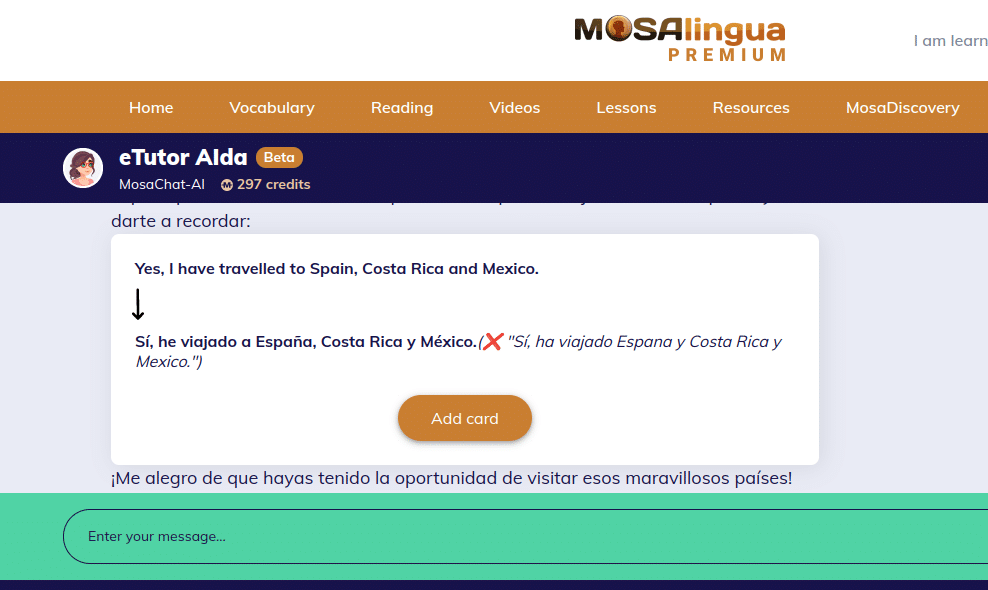
MosaDiscovery
MosaDiscovery is a browser extension for integrating words and phrases found in the texts you read or in the subtitles of YouTube and Netflix videos.
I tried this function out, but I wasn’t really impressed with the quality of the translations, so after a few days, I stopped using MosaDiscovery.
I’m sure it will get better in time, and it will be a great feature once all the bugs are worked out.
What’s Great About MosaLingua?
Interactive flashcards
The flashcards, which are at the heart of MosaLingua, work really well, with options to hear the words and phrases, see images, spell and even record yourself saying them and then comparing that recording to a native speaker’s pronunciation of the word.
They’re easy to use and fun, and I found myself using this feature the most, learning (or re-learning) up to 20 or more words and phrases each day.
Authentic materials
It’s refreshing to have authentic materials on MosaLingua. Things like the selection of short stories, novels and videos makes it easy to access real authentic materials on the site.
AI tutor
Surprisingly, I really liked chatting with the AI tutor, Alda, on MosaLingua. At first when I saw this feature on the site, I figured it would be boring or just not work that well, but it works really well!
I got into in-depth conversations with Alda about travel, art and lots of other interesting subjects, too. I really liked how it would chat like a friend, but then stop and provide mini-lessons when I made an error in my writing.
When that happens, she continues the conversation but also provides a translation, with a brief lesson. Then, you can add that word or phrase to a flashcard, so you can practice it in the future.
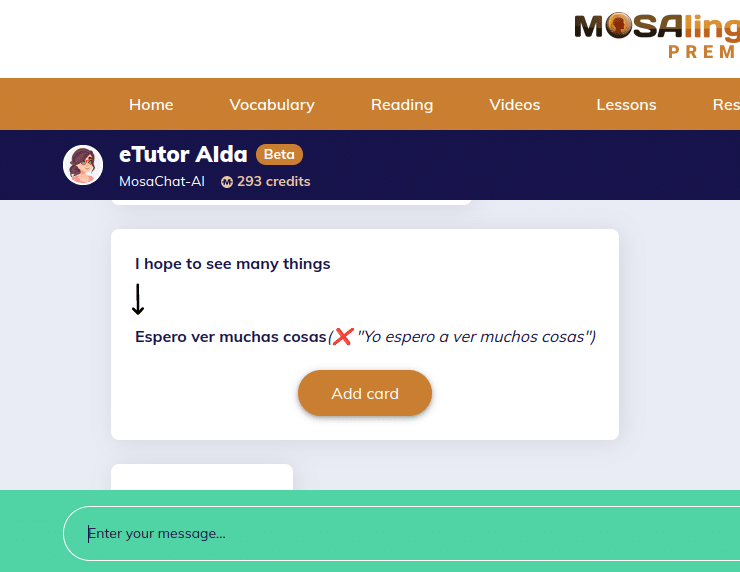
What’s Not So Great About MosaLingua?
Lackluster user experience and design
I’m not super picky when it comes to website design or user experience, but I did wonder when I was using MosaLingua whether the site and the function couldn’t be better, and well, more exciting.
The colors are all quite muted and some of the technology seems a bit dated. There were also several times that the program froze or didn’t work how I wanted it to.
When you compare the site to similar competitors like Drops or Duolingo, MosaLingua feels a little dated.
Lack of gamification features
Speaking of Duolingo and Drops, who specialize in fun, gamified learning experiences that keep you entertained while you learn, MosaLingua, I felt, would benefit from some of this approach.
Even though the program lets you choose various challenges, like learning five words a day, there aren’t any other gamified elements. When you combine this with the lack of bright and fun visuals, it can feel a little less exciting than similar language learning programs.
MosaLingua Versus Other Language Learning Programs
MosaLingua positions itself as a holistic learning program, so in theory, you should be able to learn a whole language through the program. Nevertheless, there are some elements it’s lacking, which is where these other language learning programs could come in.
MosaLingua vs. Memrise

Memrise is very similar to MosaLingua in that they both use spaced repetition, flashcards and authentic videos. But for me, Memrise is just way better in terms of design and user friendliness.
Memrise lacks explicit grammar instruction, though, and there aren’t reading opportunities, so they both have a place.
Here’s our full Memrise review.
MosaLingua vs. Drops

Drops is more gamified-feeling than MosaLingua and it doesn’t feel like a holistic learning program; rather it’s a supplementary app that you can use in addition to whatever main program you’re using.
Drops limits each session to five minutes, and if you want premium content (anything above beginner level), it actually costs more than MosaLingua at $13 per month.
Overall, I’d choose MosaLingua in this match-up. You get the vocabulary plus a bunch of other stuff for a lower price.
Here’s our full review of Drops.
MosaLingua vs. FluentU

I know many people who’ve told me that they learned English through watching movies and TV. In fact, I’ve heard it so many times, I definitely believe it. So I like to use this method, too.
FluentU works really well for me because I’m a person who really likes to watch TV, movies, music videos, news and vlogs on YouTube. So it feels like a really sustainable and fun way to learn and review a language and it’s worked really well for me. Plus, the video library of FluentU is way, way bigger than MosaLingua’s video library.
I find myself spending hours on FluentU, all while feeling engaged, while 20 minutes on MosaLingua sometimes feels like a slog.
Overall, I think FluentU and MosaLingua would complement each other nicely, and the cost would still be pretty affordable.
FluentU takes authentic videos—like music videos, movie trailers, news and inspiring talks—and turns them into personalized language learning lessons.
You can try FluentU for free for 2 weeks. Check out the website or download the iOS app or Android app.
P.S. Click here to take advantage of our current sale! (Expires at the end of this month.)
What Does MosaLingua Cost?
MosaLingua Premium starts at $4.99 per month. This can vary slightly depending on what currency you’re paying in.
Here’s a link to MosaLingua’s price page.
The Final Verdict: Does MosaLingua Live Up to Its Promises?
Overall, I liked a lot about MosaLingua and I genuinely felt that my Spanish learning was moving along nicely while using it.
I especially enjoyed the flashcards feature and the AI tutor section, which helped me a lot more than I thought it would.
What didn’t seem quite as good to me was the user-friendliness and experience, which just felt a little dated and less exciting when compared to other programs like Duolingo or Memrise.
I think perhaps the more serious language learners will respond to MosaLingua the most. It can really be effective if you’re a self-motivated learner who wants to get fluent fast.
So there you have it: our full MosaLingua review. Give it a try yourself if you think it sounds right for you.
And One More Thing...
If you dig the idea of learning on your own time from the comfort of your smart device with real-life authentic language content, you'll love using FluentU.
With FluentU, you'll learn real languages—as they're spoken by native speakers. FluentU has a wide variety of videos as you can see here:
FluentU has interactive captions that let you tap on any word to see an image, definition, audio and useful examples. Now native language content is within reach with interactive transcripts.
Didn't catch something? Go back and listen again. Missed a word? Hover your mouse over the subtitles to instantly view definitions.
You can learn all the vocabulary in any video with FluentU's "learn mode." Swipe left or right to see more examples for the word you’re learning.
And FluentU always keeps track of vocabulary that you’re learning. It gives you extra practice with difficult words—and reminds you when it’s time to review what you’ve learned. You get a truly personalized experience.
Start using the FluentU website on your computer or tablet or, better yet, download the FluentU app from the iTunes or Google Play store. Click here to take advantage of our current sale! (Expires at the end of this month.)






